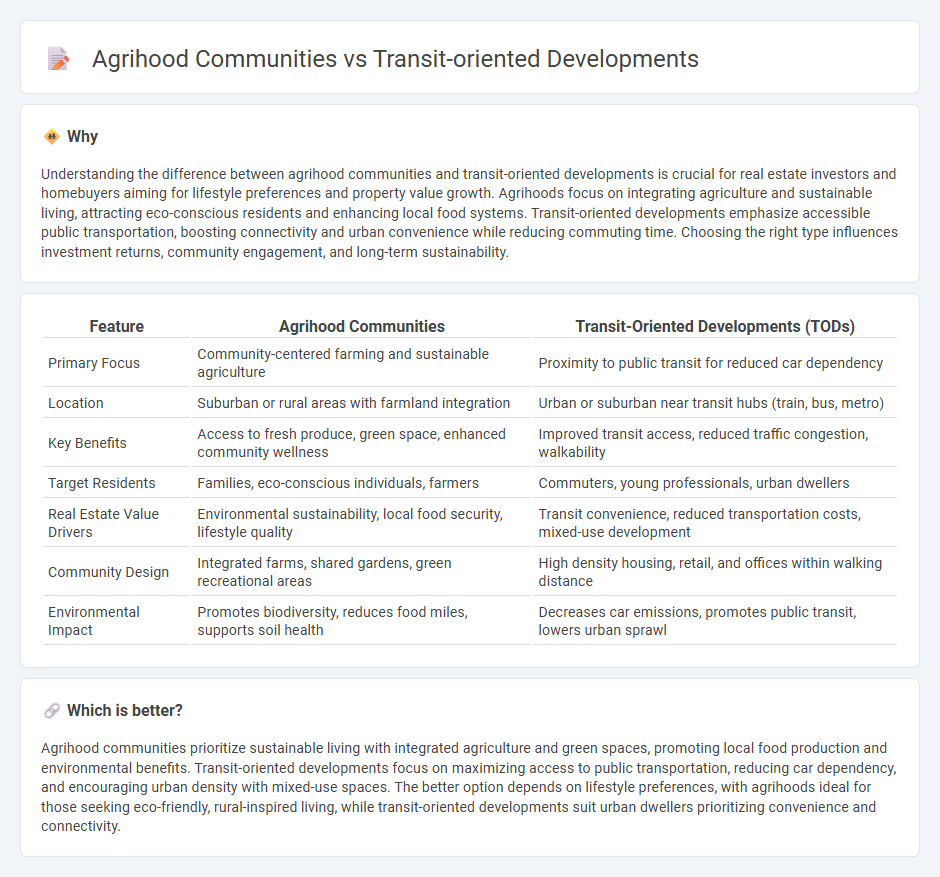
Agrihood communities integrate sustainable farming and residential living, promoting locally grown food and green spaces, which enhance community health and environmental stewardship. Transit-oriented developments focus on creating walkable neighborhoods centered around public transit hubs, reducing reliance on cars and encouraging urban density for economic and environmental benefits. Explore the distinct advantages and lifestyle opportunities of agrihoods versus transit-oriented developments to determine the best fit for your real estate goals.
Why it is important
Understanding the difference between agrihood communities and transit-oriented developments is crucial for real estate investors and homebuyers aiming for lifestyle preferences and property value growth. Agrihoods focus on integrating agriculture and sustainable living, attracting eco-conscious residents and enhancing local food systems. Transit-oriented developments emphasize accessible public transportation, boosting connectivity and urban convenience while reducing commuting time. Choosing the right type influences investment returns, community engagement, and long-term sustainability.
Comparison Table
| Feature | Agrihood Communities | Transit-Oriented Developments (TODs) |
|---|---|---|
| Primary Focus | Community-centered farming and sustainable agriculture | Proximity to public transit for reduced car dependency |
| Location | Suburban or rural areas with farmland integration | Urban or suburban near transit hubs (train, bus, metro) |
| Key Benefits | Access to fresh produce, green space, enhanced community wellness | Improved transit access, reduced traffic congestion, walkability |
| Target Residents | Families, eco-conscious individuals, farmers | Commuters, young professionals, urban dwellers |
| Real Estate Value Drivers | Environmental sustainability, local food security, lifestyle quality | Transit convenience, reduced transportation costs, mixed-use development |
| Community Design | Integrated farms, shared gardens, green recreational areas | High density housing, retail, and offices within walking distance |
| Environmental Impact | Promotes biodiversity, reduces food miles, supports soil health | Decreases car emissions, promotes public transit, lowers urban sprawl |
Which is better?
Agrihood communities prioritize sustainable living with integrated agriculture and green spaces, promoting local food production and environmental benefits. Transit-oriented developments focus on maximizing access to public transportation, reducing car dependency, and encouraging urban density with mixed-use spaces. The better option depends on lifestyle preferences, with agrihoods ideal for those seeking eco-friendly, rural-inspired living, while transit-oriented developments suit urban dwellers prioritizing convenience and connectivity.
Connection
Agrihood communities integrate sustainable agriculture into residential neighborhoods, fostering local food production and green spaces that enhance quality of life. Transit-oriented developments (TODs) focus on creating walkable, mixed-use areas near public transit hubs to reduce car dependency and promote accessibility. Both models prioritize sustainable living by combining environmental benefits with urban planning strategies that encourage community engagement and reduce carbon footprints.
Key Terms
**Transit-Oriented Developments:**
Transit-Oriented Developments (TODs) prioritize high-density, mixed-use spaces centered around public transportation hubs to reduce reliance on cars and promote sustainable urban living. These developments integrate residential, commercial, and recreational areas within walking distance of transit stations, enhancing accessibility and reducing environmental impact. Explore the benefits and design strategies behind successful TOD projects to understand their transformative role in modern urban planning.
Mixed-Use Zoning
Transit-oriented developments prioritize dense, walkable neighborhoods around public transit hubs, emphasizing mixed-use zoning to integrate residential, commercial, and office spaces seamlessly. Agrihood communities incorporate agricultural land within residential areas, where mixed-use zoning supports local food markets, community farms, and green space alongside homes. Explore how mixed-use zoning shapes the distinct urban benefits and lifestyles of transit-oriented developments versus agrihood communities.
Walkability
Transit-oriented developments (TODs) emphasize high walkability with dense, mixed-use environments centered around public transit hubs, promoting reduced car dependency and enhanced pedestrian access. Agrihood communities combine residential living with agricultural spaces, offering walkable paths primarily designed for leisure and community farming rather than transit efficiency. Explore the benefits of walkability in both community designs to understand their unique impacts on sustainable living and quality of life.
Source and External Links
Transforming the Urban Space Through Transit-Oriented Development - Transit-oriented development (TOD) is a planning strategy focusing on clustering jobs, housing, and services around public transport stations to create compact, mixed-use, pedestrian- and bicycle-friendly urban spaces that boost economic productivity and make cities more livable.
Transit-oriented development - TOD maximizes residential, business, and leisure spaces within walking distance of public transport, encouraging walkable, mixed-use communities and has been applied extensively in cities like Vancouver and proposed in others like Bangkok for reducing congestion and improving quality of life.
Transit-Oriented Development | FTA - The U.S. Federal Transit Administration promotes TOD to create dense, walkable, mixed-use developments near transit which support affordable housing, neighborhood revitalization, increased transit ridership, and environmental benefits, backed by significant funding programs.
 dowidth.com
dowidth.com